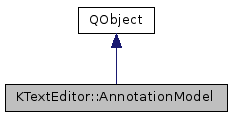KTextEditor
#include <annotationinterface.h>

Signals | |
| void | lineChanged (int line) |
| void | reset () |
Public Member Functions | |
| virtual | ~AnnotationModel () |
| virtual QVariant | data (int line, Qt::ItemDataRole role) const =0 |
Detailed Description
An model for providing line annotation information.
Introduction
AnnotationModel is a model-like interface that can be implemented to provide annotation information for each line in a document. It provides means to retrieve several kinds of data for a given line in the document.
Implementing a AnnotationModel
The public interface of this class is loosely based on the QAbstractItemModel interfaces. It only has a single method to override which is the data() method to provide the actual data for a line and role combination.
- Since
- 4.1
Definition at line 53 of file annotationinterface.h.
Constructor & Destructor Documentation
|
inlinevirtual |
Definition at line 58 of file annotationinterface.h.
Member Function Documentation
|
pure virtual |
data() is used to retrieve the information needed to present the annotation information from the annotation model.
The provider should return useful information for the line and the data role.
The following roles are supported:
- Qt::DisplayRole - a short display text to be placed in the border
- Qt::TooltipRole - a tooltip information, longer text possible
- Qt::BackgroundRole - a brush to be used to paint the background on the border
- Qt::ForegroundRole - a brush to be used to paint the text on the border
- Parameters
-
line the line for which the data is to be retrieved role the role to identify which kind of annotation is to be retrieved
- Returns
- a QVariant that contains the data for the given role.
|
signal |
The model should emit the signal lineChanged() when a line has to be updated.
- Note
- Kate Part implementation details: lineChanged() repaints the whole annotation border automatically.
|
signal |
The model should emit the signal reset() when the text of almost all lines changes.
In most cases it is enough to call lineChanged().
- Note
- Kate Part implementation details: Whenever reset() is emitted Kate Part iterates over all lines of the document. Kate Part searches for the longest text to determine the annotation border's width.
- See also
- lineChanged()
The documentation for this class was generated from the following file:
Documentation copyright © 1996-2014 The KDE developers.
Generated on Tue Oct 14 2014 22:52:20 by doxygen 1.8.7 written by Dimitri van Heesch, © 1997-2006
KDE's Doxygen guidelines are available online.
 KDE API Reference
KDE API Reference